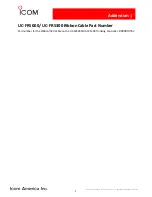
-9-
•
When the oil metering valve (carburetor) is full and the line is up to pressure, the
pump will still “tick” but less frequent depending on the demand from the oil
metering valve. NOTE: Include the pump in a control circuit with a 3 amp fuse )
(16 awg wire) so you can turn it off when the heater/stove is not in use.
•
NOTE: If the power to the pump is shut off, the fuel could still flow through to
the pump by way of siphon. The flow of fuel should be turned off using the
shut-off valve near the heater/stove as well as the oil metering valve.
•
IMPORTANT! This pump must be installed as high as the oil metering valve (or
higher). This pump is a “pull” pump rather than a push pump, and must be
installed so that the fuel oil is pulled as high as the oil metering valve and gravity
feeds back down to the valve. Use a rubber backing as a washer to soften the
sound of the pump and use appropriate screws to mount the pump.. If there is no
fuel getting to the oil metering valve, you may need the heavy duty pump #
15079, or call / email Sig Marine for retrofitting a stronger pressure spring in your
pump and installing a pressure regulator # 15074 between the pump and the
valve(converting a #20-000 FRD-2 pump to a #20-002 FRD-HD pump).
•
The pumps can be installed with fuel inlets and outlets up or down (1/8 npt
thread), however mounting the pump with the fuel inlet on top (Note the fuel
OUTLET is on the end of the pump that has the wire connections and the 3
assembly screws), will give the pump extra pressure and is easier to clean but will
need to be primed the first time only to remove air in the fuel line). There are 3
check valves in the pump to prevent the back flow of fuel, so the pump should
stay primed. If the pump does not stay primed then 1 of the check valves in the
pump needs cleaning.
•
To prime the pump disconnect the fuel line at the valve fuel inlet and pump fuel
into a container to remove all the air in the fuel lines. After a cup of fuel has been
pumped, reconnect fuel line to the valve.
•
The pump should be installed in a ventilated area and not near a hot exhaust.
•
Ground to negative battery (not recommended for gasoline).
•
To retrofit the pump to a higher pressure unscrew the 3 torx screws (t-20) and
with twisting the lid back and forth, pull it straight back off. Note the pump
plunger, spring, check valve , and a very small amount of fuel will drop out if
installed as per diagram. Place the check valve as shown in the diagram on top of
the heavier replacement spring, and the spring on top of the pump plunger and
push it back into the pump body holding it in with a finger. Note the magnetic
part of the plunger is on the opposite end of the spring. Replace the lid with the
gasket on by lowering your finger on to the red O ring sleeve without the
plunger falling out ( the plunger is about 2” long so you have room to lower your
finger out of the way). The red O ring sleeve will fit inside the pump tube and the
black O ring will fit over the outside of the pump tube and will require twisting
and pushing the lid straight back in. This is a little tight but that is what makes
the seal. Rotate the gasket and replace the screws.












































